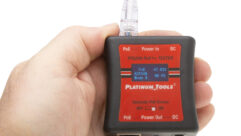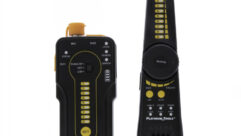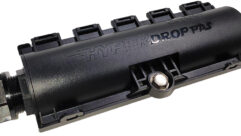How, When, Where: Wire
Jul 1, 2002 12:00 PM,
Glen Ballou
Wire is not the only means of getting a signal from one device toanother; fiber optics, high-frequency radio, microwaves and satellitetransmission are also available. Wire has one big advantage over theother methods, however, in that it does not require electronic deviceson each end to convert it from one medium to another. Wire is still themost used method to connect one circuit or component to another.
When installing wire, contractors must follow the NationalElectrical Code, developed to ensure the safety of people and propertyagainst fires and electrical hazards. The NEC is widely accepted as theset of regulations governing the proper installation of wire and cablein the United States, though each state, county, city and municipalityhas the option to adopt all of the code, part of the code, or todevelop one of its own. The local inspectors have final authority; sothough the NEC is a good reference when questions arise about theproper techniques for a particular installation, local authorities mustbe contacted for verification.
Once you have met the codes, the next step is to determine the sizeof the wire you need to use. Resistance is an important factor indetermining wire size. For instance, connecting an 8½ loudspeakerto an amplifier 500 feet away through a No. 19 wire causes 50 percentof the power to drop in the wire in the form of heat. A handy rule ofthumb is that 1000 feet of No. 16 wire has a resistance of about4½. Each time the wire size changes by three (from No. 16 to No.19 or No. 13), the resistance doubles or halves. When determining wireresistance, the length of wire in a pair is twice the length of thetotal cable run.
In the United States, wire is sized by the American Wire Gaugemethod. Wire sizes from No. 4 to No. 30 are used most often. Wire witha number less than four is very heavy and cumbersome, and wire greaterthan No. 24 is fragile and has high resistance. Table 1 gives theresistance and current carrying capabilities of wire.
The current carrying capacity of wire is controlled by NEC Tables310-16, 310-15(b)(2)(a) and Section 240-3. Table 310-16 shows themaximum current carrying capacity for insulated conductors rated fromzero to 2000 V, including copper and aluminum conductors. Eachconductor amperage is given at 60, 75 and 90 degrees Celsius. Becausethe melting point of copper is much higher than that of the insulation,the current limit on a copper wire is the melting point of theinsulation and is listed by most manufacturers. The materials won’tmelt at the specified temperature but may begin to fail certain tests.The maximum continuous current rating for an electronic cable islimited by conductor size, number of conductors contained within thecable, maximum temperature rating of the cable and environmentalconditions such as ambient temperature and air flow.
NEC Table 310-15(b)(2)(a) contains amperage adjustment factors forwhenever more than three current carrying conductors are in a conduitor raceway. Figure 2 simplifies the number of cables in a conduit andthe current carrying capacity of each conductor. Referring to thecurrent capacity chart, determine conductor gauge, insulation andjacket temperature rating and number of conductors from the applicableproduct description for the cable. Next, find the current value on thechart for the proper temperature rating and conductor size. The maximumcurrent rating/conductor is found by multiplying the chart value by theappropriate conductor factor. The chart assumes an ambient temperatureof 25 degrees Celsius and no air movement. Current values are valid forcopper conductors only.
The current ratings in Figure 2 are intended as general guidelinesfor low-power electronic communications and control applications.Current ratings for power applications are generally set by regulatoryagencies such as Underwriters Laboratories, Canadian StandardsAssociation, NEC and others and should be used for finalinstallation.
Section 240-3 of the NEC gives the requirements for overloadprotection for conductors other than flexible cords and fixture wires.Section 240-3(d) Small Conductors, states that No. 14 to No. 10conductors require a maximum protective overcurrent device with arating no higher than the current rating listed in the 60 degreesCelsius column. These currents are 15 A for No. 14 copper wire, 20 Afor No. 12 copper wire, and 30 A for No. 10 copper wire. Anotherimportant limitation comes from temperature rise. When connecting wireto a terminal strip or connector, the temperature rise in theconnections must be considered. Often the circuit is not limited by thecurrent carrying capacity of the wire but by the termination point.
TO SHIELD OR NOT TO SHIELD
When in doubt, shield. With all of the noise in the environment, youface challenges from electromagnetic and radio-frequency interference.Shielded cable and twisted pairs ensure signal integrity, preventdowntime and maintain sound and picture quality. Braid shieldshave good structural integrity, flexibility and flex life. They areideal for minimizing low-frequency interference and have a lower DCresistance than foil shields. Braid shields are also effective at RFranges. We can assume a maximum coverage of 95 percent for a singlebraid shield.
Mechanically induced noise is a frequent concern in the use ofguitar cords and microphone cables that are constantly moving. Braidedshield cable usually has fillers in it to reduce triboelectric noise,generated by the mechanical motion of a cable that changes the relativeposition of one wire to the other. When wires inside the shield rubagainst each other, small electrical discharges are created. Fillershelp keep the conductor spacing constant, and semiconductive materialshelp dissipate charge buildup. Wire without fillers, such as shieldedloudspeaker cable, does not have a filler, therefore it has hightriboelectric noise so it should not be used for microphone cable.
Foil shields are aluminum foil laminated to a polyester orpolypropylene film for mechanical strength. Foil shields provide 100percent cable coverage. They are much smaller in diameter than braidshields, so they are often used to shield individual pairs of multipaircable. They have less weight and bulk and cost less than braid shieldsand are generally more effective in RF ranges. Foil shields can be moreflexible than braid but have a shorter flex life. Drain wires are usedwith foil shields to make termination easier and to groundelectrostatic discharges. Foil shields should never be used formicrophone cable or any cable with movement.
Combination shields consist of more than one layer ofshielding. They provide maximum shield efficiency across the frequencyspectrum. The combination foil-braid shield combines the advantages of100 percent foil coverage and the strength and low DC resistance of abraid. Other combination shields available include variousfoil-braid-foil, braid-braid and foil-spiral designs.
Spiral shields can be either single or double spirals and aremore flexible and easier to terminate than braided shields. Spiralshields can be considered coils of wire; therefore, they can exhibitinductive effects that make them ineffective at higher frequencies.Spiral shields are only used for analog audio applications. The Frenchbraid shield by Belden is an ultraflexible double spiral shieldconsisting of two spirals of bare or tinned copper conductors tiedtogether with one weave. The shield provides long flex life and highflexibility. It also has about 50 percent less triboelectric noise.
- Jackets and Coverings. Each type of jacket or covering has its owncharacteristics and advantages and disadvantages. Vinyl issometimes referred to as polyvinyl chloride (PVC). Several varietieshave temperature properties ranging from -67 to 221 degrees Fahrenheit(-55 to 105 degrees Celsius). Vinyl also varies in pliability andelectrical properties so that at least one type can fit almost anyapplication. The price range also varies accordingly. Typicaldielectric constant values can range from 3.5 at 1000 Hz to 6.5 at 60Hz.Polyethylene is a good electrical insulator with a lowdielectric constant value over all frequencies and very high insulationresistance. Its flexibility can be rated stiff to very hard. Moistureresistance is rated excellent, and dark formulations have excellentsunlight resistance. The dielectric constant is 2.3 for solidinsulation and as low as 1.35 for gas-injected foam cellulardesigns.Teflon has excellent electrical properties, temperature rangeand chemical resistance. It is not suitable against nuclear radiation,and it does not have good high voltage characteristics. Teflon cablesare rated 500 and 392 degrees Fahrenheit maximum (260 and 200 degreesCelsius). The cost of Teflon is approximately eight to ten times moreper pound than vinyl insulations. The dielectric constant for solidTeflon is 2.1. Foam Teflon (FEP) has a dielectric constant of 1.42.Polypropylene is similar in electrical properties topolyethylene and is primarily used as an insulation material.Typically, it is harder than polyethylene, which makes it suitable forthin wall insulations. UL maximum temperature rating may be 140 to 176degrees Fahrenheit (60 to 80 degrees Celsius). The dielectric constantis 2.25 for solid and 1.55 for cellular designs.Silicone is a very soft insulation that has a temperaturerange from -112 to 392 degrees Fahrenheit (-80 to 200 degrees Celsius).It has excellent electrical properties plus low moisture absorption andresistance to weather, ozone and radiation. Unfortunately, it has lowmechanical strength, poor scuff resistance and a high cost.Neoprene has a maximum temperature range from -67 to 194degrees Fahrenheit (-55 to 90 degrees Celsius). The most stable colorsare black, dark brown and gray. Neoprene is oil and sunlight resistant,making it ideal for outdoor applications. The electrical properties arenot as good as other insulation material, so thicker insulation isrequired.Rubber normally has natural rubber and styrene-butadienerubber (SBR) compounds. Some formulations are suitable for -67 degreesFahrenheit (-55 degrees Celsius) minimum while others are suitable for167 degrees Fahrenheit (75 degrees Celsius) maximum. Rubber jacketingcompounds are exceptionally durable, withstand high-impact and abrasiveconditions better than PVC and are resistant to degradation orpenetration by water, alkali or acid. The compounds also have excellentheat resistance and provide greater cable flexibility in coldtemperatures.
- Insulation Color Codes. Wire insulation colors help trace conductorsor conductor pairs. The most common codes are given in Tables 2 and3.
- Snakes. Snakes are an easy way to connect stage microphones and suchto a remote mixing board. Snakes have individually jacketed andshielded pairs for optimal protection against signal loss in a singlejacket. Snakes can be specified as to the type of connectors ortermination and number of pairs. Snakes offer the followingadvantages:Color codes for snakes are given in Table 4.
- Low-capacitance insulation materials
- Spiral, braid and other foil tape shields for special interferenceproblems
- Low profile appearance, high temperature resistance and coldtemperature pliability
- Jacket and insulation materials that meet NEC requirements
- Easy termination and identification
- No overall shield required to reduce crosstalk
- Long cable runs are cheaper than running multiple single channelcables.
- Plenum Cable. Plenum cable must be used in ceilings where the airhandling system uses the plenum as the delivery or the return air duct.In a typical modern commercial building with hung ceilings, cables areinstalled in the enclosed space between ceilings and the floor above.That area may also be used as a return air plenum for a building’sheating and cooling system — an invitation to disaster if a firebreaks out. If the fire is able to feed on combustible materials (suchas cable insulations) in the plenum, the fire can spread rapidly.That’s the reason NEC requires that conventional cables always beinstalled in metal conduit when used in plenums.In 1981 the jacket and insulation compound used in plenum cables wastested and found acceptable under the terms of the NEC and wasclassified by Underwriters Laboratories Inc. for use without conduit inair return ducts and plenums. Originally, plenum cable was Teflonjacketed. Today most plenum cables have a special PVC jacket that meetsthe fire rating. Although plenum cable costs more than conventionalcable, the overall installed cost is dramatically lower because iteliminates the added cost of conduit and saves time and labor requiredto install it.
- Multiconductor Cables. When many lines carrying different programsor signals are run in the same conduit, they induce crosstalk currentsinto each other. Crosstalk is induced by two methods:electromagnetically due to unbalanced coupling between one circuit andothers or electrostatically due to unbalanced capacitance to othercircuits, which develops a voltage difference between one circuit andthe others (or to its own or other shields carrying current). The mainways to eliminate crosstalk include using shielded cables, usingtransformers on both ends and grounding the circuit. Be sure that thetwo wires of each pair are twisted, as this ensures close spacing andaids in canceling pickup by transposition. The measurements in Figure 3were made many years ago but are still valid today. All pickup wascapacitive because the leads were twisted, eliminating inductivecoupling. The test was made in a 250-foot conduit with two twistedpairs run through it. One carried 70.7 V while the second cable wasmeasured for crosstalk. Measurements made for half this length producedhalf the voltages; therefore, the results at 500 and 1000 feet wereinterpolated. The crosstalk figures are for 1 kHz. The voltages at 100Hz and 10 kHz are one tenth and ten times those figures,respectively.
In a future article I will discuss digital audio cable, coaxialcable, CCTV/CATV cable and installation techniques.
Glen Ballou owns Innovative Communications and is the author andeditor of the first, second and third editions of the Handbook forSound Engineers (Focal Press).
The National ElectricalCode
NEC’s code book has nine chapters that are divided intoarticles pertaining to specific subjects. Five articles pertain tocommunication and power-limited cable.
Article 725 covers Class 1, Class 2 and Class 3 remote control andsignaling cables as well as power-limited tray cable. Power-limitedtray cable can be used as a Class 3 or Class 2 cable. Cable listed asmultipurpose, communications or power-limited fire protective can beused for Class 2 and Class 3 applications. A Class 3 cable can be usedas a Class 2 cable.
Article 760 covers power-limited fire protective cable. Cable listedas power-limited fire protective cable can also be used as Class 2 andClass 3 cable. Cable listed as communications and Class 3 can be usedas power-limited fire protective cable with restrictions to conductormaterial and type gauge size and number of conductors.
Article 770 discusses three general types of fiber optic cable:nonconductive, conductive and composite.
Article 800 covers multipurpose and communication cable.Multipurpose cable is the highest listing for a cable and can be usedfor communication, Class 2, Class 3 and power-limited fire protectivecable. Communication cable can be used for Class 2 and Class 3 cableand also as a power-limited fire protective cable withrestrictions.
Article 820 covers community antenna television and RF cable. CATVcable may be substituted with multipurpose or communication coaxialcable.
The NEC has designated four categories of cable for variousenvironments, and these are listed from the highest to the lowest. Ahigher-listed cable can always be used as a substitute for a lowerone.
Plenum cable is suitable for use in air ducts, plenums and otherspaces used for environmental air without conduit because it providesadequate fire-resistant and low smoke-producing characteristics.
Riser cable is suitable for use in a vertical run, in a shaft orfrom floor to floor, and it has fire-resistant characteristics capableof preventing the spread of fire from floor to floor.
General Purpose cable is resistant to the spread of fire. It issuitable for general-purpose use, with the exception of risers, ducts,plenums and other space used for environmental air.
Restricted Applications cable has limited use, is suitable for usein dwellings and in raceways and is flame retardant. Restricted use islimited to nonconcealed spaces of 10 feet or less, fully enclosed inconduit or raceway, or cable with diameters less than 0.25 inches for aresidential dwelling.
NEC cable hierarchy, Figure 1, defines which cables can replaceother cables. The chart starts with the highest listed cable on the topand descends to the lowest listed cable on the bottom. Following thearrows defines which cable can be substituted for others.
When choosing cable for an installation, check the application andenvironment to determine which type of cable to use and what rating itshould have. Because the NEC code is a general guideline that can beadopted in whole or in part, contact local authorities to verify localcodes.
Any substitutions must be done with a higher-rated cable than whatthe code calls for. The local inspector or fire marshal has the finalauthority to approve or disapprove any installation of cable based onthe NEC or on the local code, so make sure you check with thoseauthorities.










